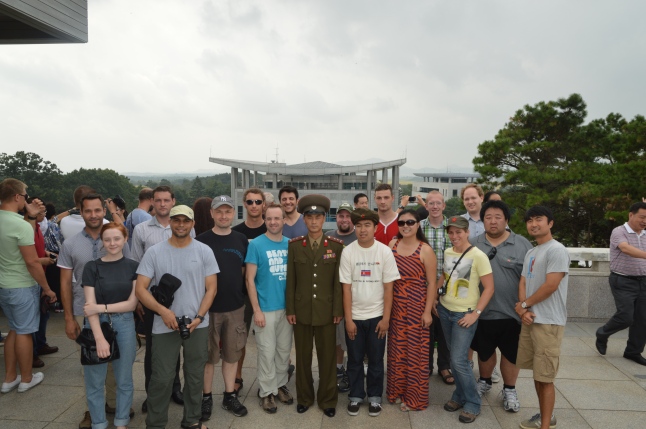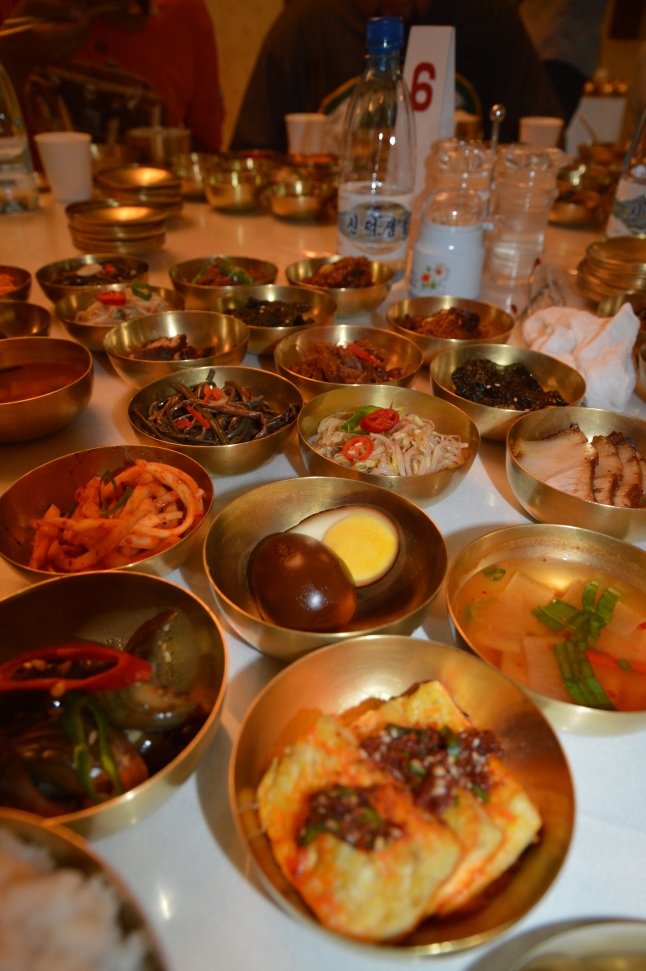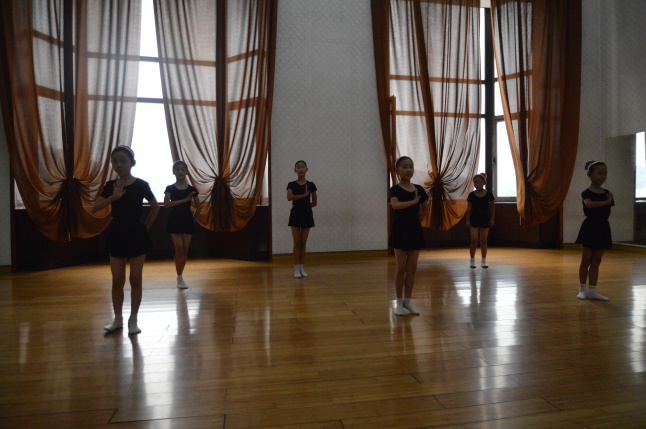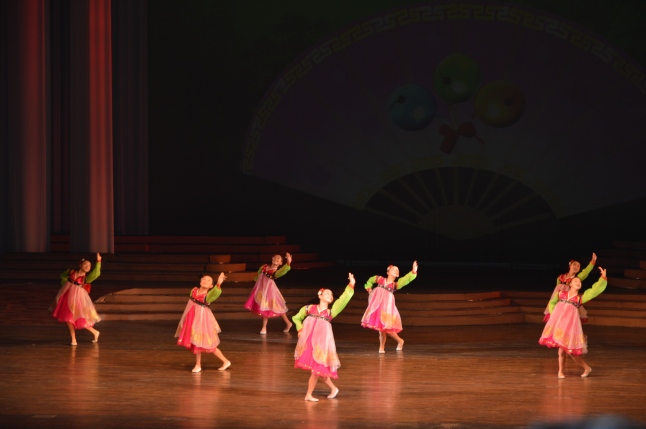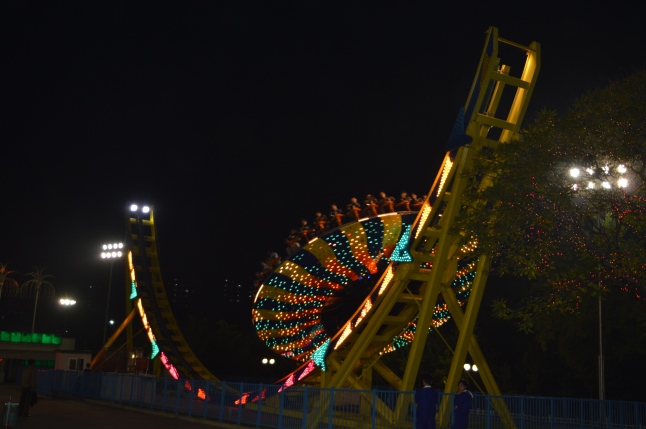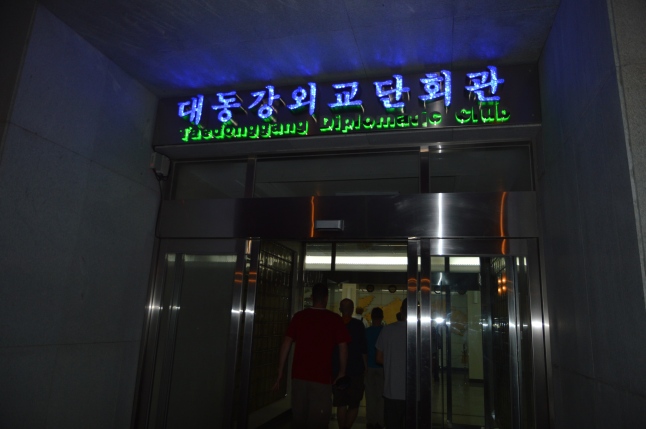The reason we stayed in Kaesong is because of its proximity to the DMZ, the Demilitarized Zone at the North/South border. We visited the DMZ by bus the next morning and were briefed about the area. Again, we had to walk in a single file line for this activity. The DMZ is an area of hightened security 2KM south and 2KM north of the border. Within the DMZ on the North side is a flagpole that the North Koreans proudly declared is taller than the one in the South. We were first taken to an area with two unassuming one story buildings, the locations of initial war negotiations and the location of the final signing of the armistice. The North Korean version of the events was very entertaining. Of course, the war was started by the US Imperialists and the North was the victim in all situations. The English speaking guide at the DMZ noted that “If US Imperialists were to attack DPRK again, the mighty Korean army will crush the Americans in one stroke!” It was hard not to laugh and I wondered if normal North Koreans realize holding a grudge for so long is silly as the US has moved on from the Korean War many years ago.
We were taken to Panmunjom, the official border area between the North and the South. We were not able to see any soldiers on the South Korean side but we did get a chance to snap a group photo with a North Korean soldier. The visit to the DMZ turned out to be more low-key and less exciting than I had imagined. I thought we’d be able to walk inside the conference rooms that literally sit on the border. Instead, we were asked to take photos from the observation deck.
The rest of our morning in Kaesong was filled with a visit to a (supposed) Tomb of King Kongmin, of the Goryeo Dynasty and a trip to a Confucian School which is now the Koryo Museum. The drive up to the tomb on a windy mountan road with very little visibility due to the extremely heavy morning fog was one of the scariest moments in the DPRK. The tomb was beautiful and is either 1) extremely well preserved, 2) recently restored back into immaculate condition, or 3) fake and built as a tourist attraction. Your guess is as good as mine.
The Confucian School was also a cultural museum and our guide boasted about the accomplishments of the ancient Korean people.
I’ve been called a foodie before and I’m not sure I’d use that word to describe myself but I certainly do love to eat. Food on the tour was rather disappointing and while tours tend to be synonymous with bad food, I do think in this case, the bad food was more of a function of being in North Korea. North Korea has relied on humanitarian aid for decades; the Soviet Union used to be the main provider of aid and upon its fall, China stepped into that role. In the mid-1990s, North Korea suffered from a huge human tragedy and famine striked the country in full force. Unwillingness to disclose the true magnitude of the problem, the inefficiencies in the food distribution network, and rampant government corruption led to the deaths of up to several million people. Although the famine is now over, the country is still heavily dependent on aid and there has been reports that as of 2012, North Korea was on the verge of another potential famine. I read that North Korean soldiers are on average up to 5 inches shorter than their South Korean counterpart due to significant malnutrition. It’s shocking that people of the same race and ethnic background can have such a huge deviance in size due to just one generation’s worth of economic development and food. The diet of most North Koreans relies heavily on rice and corn. Dishes are generally vegetarian and meat is reserved for national holidays and special events. Even the little meat that we were served during our stay comprised mostly of fat and was not of good quality. To this day, North Koreans use ration coupons for food, although there are now markets where they can supplement their rations if they have the money to do so. DPRK packaging highlights the calorie count of the food contents; but unlike developed nations where we count calories to prevent obesity, North Koreans choose foods with the highest calorie count so that they are full and have energy. There were virtually no overweight people in North Korea. I guess that’s a benefit of having just barely enough food to eat.
Back to my point about bad food on the tour: there was one good meal that we ate and it was the day we were in Kaesong. The meal consisted of 11 side dishes, served with rice and soup. The display was very pretty and the flavors were quite good. In Kaesong, we were also offered to eat dog meat soup but of course, I declined or Benjamin would never forgive me. I even showed his photos to my fellow tour participants to try to deter them from ordering the soup, but my efforts were unsuccessful.
After lunch in Kaesong, we headed on the three hour bus ride back to Pyongyang, an opportunity for us to catch up on some desperately needed sleep. When I woke up, we had arrived at the Mangyondae Children’s Palace, a gigantic extracurricular complex for Pyongyang’s schoolchildren.
Apparently, President Kim Il Sung had declared that children are the kings of the nation and since kings lived in palaces, a palace should be built for the children as well. We were shown around by one of a teenager wearing a red scarf (reminded me of China). Inside were various classrooms teaching a variety of activities: dancing, instruments, singing, taekwondo, go (chess game), calligraphy, embroidery, etc. We also attended a formal performance put on by the students. At the entrance to the theater, we had the option of buying plastic flowers for the performers for 4 Euros. I’m pretty sure they take away the flowers from the kids after the performance and reuse it the next time so I was not willing to spend my money on reused flowers. The performance itself was very professional and quite impressive but I question how many of the students are at the Children’s Palace by their own volition. The performances are held a couple of times a week and are put on to entertain tourists as well as local schoolchildren.
It had been a long day already at this point but our guides still had much more planned. After another mediocre meal, this time at some duck bbq restaurant, we ended up at the Kaeson Youth Park Fun Fair, a DPRK amusement park. Never did I think I’d be riding a roller coaster in North Korea. Yes, I questioned the safety of the equipment but I was told that everything is brand new and that all of the rides are imported from Italy. Because we paid many times the price that locals paid, we were able to skip the lines at all of the rides. It was an exciting experience to be riding bumper cars with locals.
To finish off the night, we headed to the Diplomat Club, one of the only places in Pyongyang open late. As the name suggests, the social club (like a country club without a golf course) is aimed toward foreigners who live and work in the DPRK but we were welcomed as well. It had the same set of amenities as the Yanggakdo Hotel: swimming pool, bar, restaurant, billiards, pingpong, massage, karaoke, and the like. We stayed up past midnight enjoying the facilities and then finally headed back to the hotel for brief nap.


